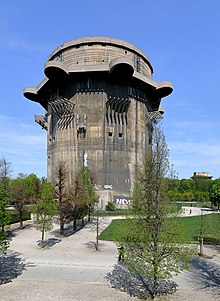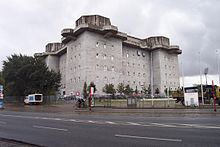Flak tower

As flak towers more are Hochbunker referred that during the Second World War in Berlin , Hamburg and Vienna for anti-aircraft guns built (Flak) and their fire control systems and also as shelters were used. There are no comparable buildings in large cities in other countries.
construction
Eight pairs of flak guns were erected as part of the aerial warfare to make it difficult for enemy bomber units to fly over or attack . The towers were designed by the Schwerin town planner and bridge builder Friedrich Tamms , who became a town planner in Düsseldorf after the war. In addition to the function as a flak position, there were large shelters in the towers for up to 30,000 people. They also housed many art and cultural treasures, such as the zoo bunker, some parts of the Pergamon Altar , in order to save them from destruction. After the end of the war, the flak towers could not be blown up because of their construction without endangering the surrounding area. The towers and their remains are therefore an integral part of the cityscape of Vienna, Hamburg and Berlin today.
meaning

The main purpose of the towers, with their reinforced concrete walls and ceilings up to 3.5 m thick , was to provide a high platform for the 12.8 cm Flak 40 and the 12.8 cm Flak-Zwilling 40 (the so-called "Twelve -Eight-twin "), which otherwise could not be used due to the gas pressure when firing in densely built-up areas. The firepower of the main guns was not greater than when they were placed on the ground due to the increased placement, but the guns were able to fully utilize their maximum horizontal firing range of 20.9 km. The maximum height attainable in an oblique shot was 14.8 km.
The greatest benefit of the towers was their robust construction, which offered the civilian population protection against air raids, as well as the possibility of safe storage of valuable art and cultural treasures. Each tower had its own emergency power generator and an autonomous water supply through deep wells.
When the air raids on cities of the German Reich increased, the Nazi propaganda used pictures of the towers for example. B. in newsreel reports as symbols of a strong defense.
The designers were aware that the flak towers could not be easily removed after the war, which is why a cladding of the towers in the classic style was planned; so they should be integrated into the cityscape like ancient fortresses. For this reason only, window openings with lockable steel shutters were built in, which tended to be weak points during the war.
During the Battle of Berlin in April / May 1945, the flak towers proved to be strong obstacles for the advancing Red Army : the guns also fought the Soviet tanks . Since April 26, 1945, the (Soviet) 3rd Shock Army was lying in front of the Humboldthain Flakturm, the 5th Shock Army in front of the Friedrichshain Flakturm and the 28th Army with the 2nd Guards Armored Army in front of the Flakturm Zoo; only the 8th Guards Army with the 3rd Guards Armored Army was able to penetrate into the center of Berlin between the towers at the zoo and in Friedrichshain. It was not until the end of the fighting in Berlin on May 2, 1945 that the Berlin flak towers stopped firing.
Types
Flak towers were always built in pairs, a G (eschütz) tower and an L (eit) tower, with the G tower housing the four main guns and the L tower taking over the fire control at some distance . The towers were wired together. The towers in Volkspark Humboldthain, for example, were connected by a cable duct that was 1.5 m in diameter and was used as an escape tunnel at the end of the war.
The four primary weapons were 12.8 cm twin anti-aircraft guns, the positions were temporarily 3.7 cm anti-aircraft guns, and from 1944 2 cm anti-aircraft guns . It was also possible to station the Würzburg-Riese radar system . In the 3rd design, the main guns were so close together that they were protected by armored domes .
Combat tower
| class | Length [m] | Width [m] | Height 1 [m] | Wall thickness [m] | Ceiling thickness [m] | image |
|---|---|---|---|---|---|---|
| Type 1 | 75 | 75 | 39 | 3.5 | 5 |

|
| Type 2 | 57 | 57 | 42 | 2 | 3.5 |

|
| Type 3 | 43 | 43 | 55 | 2.5 | 3.5 |

|
The combat towers were the carriers of the four 12.8-cm anti-aircraft twin cannons. In the case of type I towers, it was still possible to set up a fire control station in the center of the guns in the event that the fire control tower should fail. The battle towers are larger and more massive than the guiding towers, with type III they differ most significantly. Swallow nests on a lower platform were equipped with the smaller 2 cm flak to defend the tower against particularly close and low flying machines.
Guide tower

The fire control towers contained the necessary technical equipment for determining the shot values (direction and height or distance). For detecting enemy aircraft large radar devices of the type "were on the roof Würzburg giant " set up, the continuously determined, the height and lateral guide values, which are then in the "re-evaluation" in the interior of the bunker of special analog computers processed ( "predictors") and electrically were transferred to the heavy batteries on the combat tower. The design of the guiding towers is roughly the same from type 1 to 3, but they are significantly narrower than the corresponding combat towers. In contrast to these, the guiding towers were usually only equipped with a few 2 cm anti-aircraft guns in " swallow nests " for self-defense.
Flak towers
Most of the Berlin flak towers were blown up after the war and the Hamburg flak towers were redesigned. Only the Viennese flak towers are practically unchanged, since demolition or demolition was not possible at the time due to the close proximity to residential buildings and is no longer intended today for reasons of monument protection.
| Surname | Location | design type | completion | current condition / usage |
|---|---|---|---|---|
| Flak tower I | Berlin-Tiergarten , Great Tiergarten | 1 | April 1941 | August 30, 1947, September 4, 1947, June 1948, blown up and dismantled |
| Flak tower II | Berlin-Friedrichshain , Volkspark Friedrichshain | 1 | October 1941 | April 20, May 2, 1946 blown up and covered over |
| Flak tower III | Berlin-Gesundbrunnen , Volkspark Humboldthain | 1 | April 1942 | Partially blown up on February 28, 1948, today viewing platform, climbing wall , museum |
| Flak tower IV | Hamburg-St. Pauli , Heiligengeistfeld | 1 | October 1942 | G-Tower: use as a media center. Contains the recording studios of the SAE, the music store Amptown / Just Music and the music club Uebel & Hazardous , L-tower: at the beginning of the 1950s used by NWDR television , demolished in 1973/74 |
| Flak tower V | Vienna , Stiftskaserne / Esterházypark | 3 | July 1944 | G tower: Armed Forces , L tower: House of the Sea , climbing wall , torture museum |
| Flak tower VI | Hamburg-Wilhelmsburg | 2 | October 1943 | G-tower: October 17, 1947 badly damaged inside by blasting, converted from 2010-2013 into an “energy bunker” , L-tower: October 10, 1947 blown up and removed |
| Flak tower VII | Vienna, Augarten | 3 | January 1945 | G-turret damaged inside in an accidental ammunition explosion in 1946, both unused |
| Flak tower VIII | Vienna, Arenbergpark | 2 | October 1943 | G-Tower: Depot of the Museum of Applied Arts (MAK), L-Tower: occasional exhibitions and tours, data center (planned from 2014) |
Other structures, mostly popularly known as flak towers:
literature
- Marcello La Speranza: Flak tower archeology, a found book on the Viennese fortress structures. Edition Berliner Unterwelten , 2012, ISBN 978-3-943112-02-3 .
- Henry Gidom: From flak tower to mountain of rubble . Edition Berliner Unterwelten, 2013, ISBN 978-3-943112-22-1 .
- Henning Angerer: Flak bunker. Concrete story. Results-Verlag, Hamburg 2000, ISBN 3-87916-057-0 .
-
Michael Foedrowitz :
- Air defense towers and their construction 1934–1945. Podzun-Pallas Verlag, Wölfersheim-Berstadt 1998, ISBN 3-7909-0656-5 .
- The flak towers in Berlin, Hamburg and Vienna. 1940-1950. Podzun-Pallas Verlag, Wölfersheim-Berstadt 1996, ISBN 3-7909-0575-5 , ( Waffen-Arsenal special volume 44).
- Andreas Hoffmann: Places that have disappeared. Prominent demolitions in Berlin. Transit Buchverlag, Berlin 1997, ISBN 3-88747-122-9 .
- Ute Bauer: The Viennese flak towers as reflected in the Austrian culture of remembrance. Phoibos Verlag, Vienna 2003, ISBN 3-901232-42-7 ; Revised reprint 2015, ISBN 978-3-85161-136-6 .
- Valentin E. Wille: The flak towers in Vienna, Berlin and Hamburg. History, meaning and new use. VDM-Verlag, Saarbrücken 2008, ISBN 978-3-8364-6518-2 .
Web links
- Topic flak towers on airpower.at
- Report about a Hamburg flak tower on geschichtsspuren.de (formerly lostplaces.de)
Individual evidence
- ↑ Flak tower becomes a server center . ORF report from February 24, 2013.